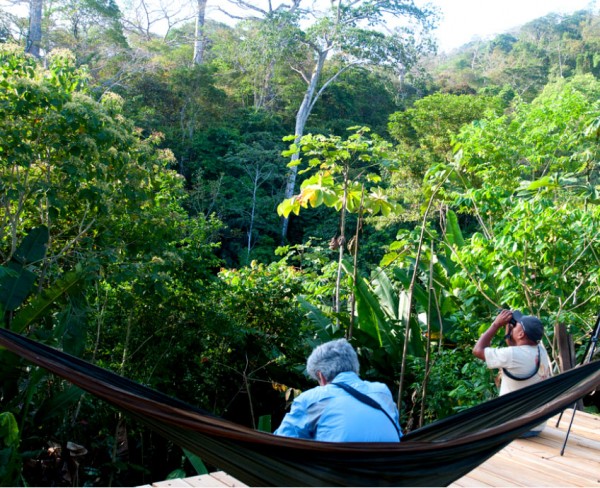
Just a short ride by seaplane from Sydney, this exquisite private getaway features just four pavilions that sleep a total of eight guests, and sits on seven and a half acres. The four exclusive pavilions have names that describe their best feature: Treetops, Bayview, Hideaway & The Retreat (2 stories). All sport views through a mass of ancient angophoras trees down to the sparkling bay waters of Pretty Beach. Each pavilion, orientated to take advantage of the surrounding views, houses a generous king bedroom, separate dressing room, deluxe bathroom, open-plan sitting area, a fully stocked bar.
The kitchen is overseen by award-winning chef Stefano Manfredi, recognized Australia-wide and internationally as a master of modern Italian cuisine, who has influenced the food scene in Australia since first opening Restaurant Manfredi. He has made his mark as chef, restaurateur, an inspired coffee blender, successful cookbook and food writer and an ambassador of sustainability. And, the wine cellar and cocktail bar at Pretty Beach House offers a hand-picked collection curated and presented by proprietor Brian Barry and sommelier Adam Lambeth.
While the property alone is a haven of natural beauty, it also pays respect to the traditional owners of the land, the Darkinjung people. Indeed, the word Bouddi is the local aboriginal name for the eastern headland of Maitland Bay. Around 100 aboriginal sites have been recorded in the park and nearby areas and many more sites are likely to exist. Sites include rock engravings, grinding grooves, rock shelters with drawings and paintings, middens and other archeological deposits. Aboriginal sites provide a valuable insight into the original culture here and interactions with the environment. They remain an important part of today’s Aboriginal culture. The national park is located near Gosford on the New South Wales Central Coast and offers several great walks, swimming and fishing.
Pretty Beach House is the perfect first stop on your Australia adventure. Explore Australia with Big Five.

While no one knows precisely where or when the hammock was first used, it was recorded by Spanish colonists, who noted its use by Native Americans, particularly in the West Indies, at the time of the Spanish conquest. The word is said to come from a Taíno culture Arawakan word (Haiti) meaning “fish net”. Early hammocks were woven out of bark from a hamack tree. Later the bark was replaced by the more available sisal fibers. One reason hammocks became popular in Central and South America was safety. By suspending their beds above ground, inhabitants were better protected from snakes, biting ants, and other harmful creatures. Portability was another reason.
One source states that Christopher Columbus introduced hammocks to Europe when he brought several of them back to Spain from islands in the present day Bahamas. Around 1590, hammocks were embraced for use aboard sailing ships, and the British Royal Navy formally adopted the canvas sling hammock in 1597.
For an exquisite place to do some serious hammock time, consider the rainforest of Darien in the most remote and least visited province in Panama. A luxury tented camp is nestled deep in the forest and offers stellar birdwatching with some 950 species, hiking trails and waterfalls. So pull up a hammock and relax on our new nine-day Panama’s Remote Province.
The Temple of the Sacred Tooth Relic, Sri Dalada Maligawa, houses one of the most sacred artifacts of Buddhism – a tooth belonging to the Buddha. The tooth, somewhat ironically, is located in Kandy in a temple in the royal palace complex of the former Kingdom of Kandy. Many believe that Buddha died around 543 BCE. According to Buddhist tradition, after the Buddha’s body was cremated, four teeth and three bones were sifted from the ashes. Exactly what happened to all the relics is not precisely known, but this tooth was taken to India and preserved in a temple in Dantapura. But in the 4th century, that city was threatened by war, so to keep it safe, it was sent to Ceylon, now Sri Lanka.
The relic long played an important role in politics. It is believed that whoever holds the relic has the power to govern the country. The safeguarding of the relic was the responsibility of the monarch, so over time, the custodianship of relic came to symbolize the right to rule.
Kandy was the last capital of the Sri Lankan kings and is a UNESCO World Heritage Site in large measure because of this temple. The present day Temple of the Sacred Tooth Relic was built by Vira Narendra Sinha, (1707–1739 CE), the last Sinhalese King of Kandy.
Sri Lanka’s Festival of the Sacred Tooth is one of the oldest and grandest of all Buddhist festivals, and features dancers, jugglers, musicians, fire-eaters and lavishly decorated elephants. The date of the ten-day observance is determined by lunar calendar and usually occurs in July or August.
Explore this fascinating island during a 16-day Sri Lanka Adventure.